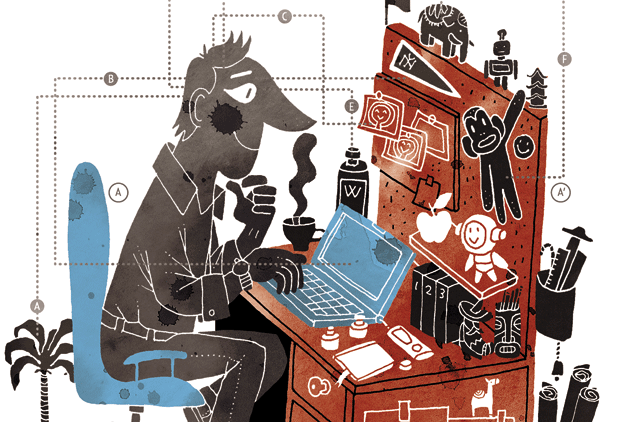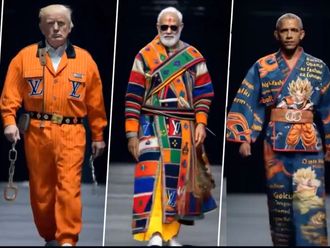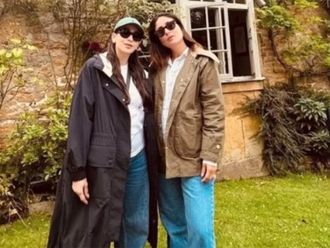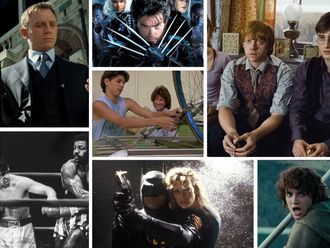
Disclaimers are usually placed at the end, but I have to begin with one: my desk does not reflect my personality.
In the past seven years I've amassed a handful of items: a dinky Shelby Mustang, a pair of miniature souvenir clogs, two travel photos, one CD cover and two seashells - all of them bequeathed possessions. Even my coffee mug was a gift.
Now, back to the disclaimer: I mention it because of a certain straw poll conducted by workmates on a quest to find out if desks reveal clues to the nature of its occupants. Their ludicrous findings concluded that my desk was nondescript, divested of personal touches. "Too sterile," they said.
Was I miffed? Rankled? Nope. I was thoroughly amused.
I've never felt the need to adorn my desk with personal effects, despite the fact that I spend more hours at work than I do at home. By way of explanation to those waving the poll results in my face, I said I keep my personal life out of the office. My disavowal to their findings however made me realise how many of my colleagues personalise their workspaces.
Curious, I looked around. At first glance, I spotted desks in varying stages of busyness - from manic chaos to functional mess and a few so neat you'd think they weren't even occupied. Apart from work-related material, there were several giveaway objects from the expected to the outré. There were souvenirs, trophies, gadgets, feng shui objects, puzzles, flags, inspirational quotes, books, cards, comic strips, dolls, cars, stuffed toys, caps, plants, curios, miniature replicas and photos from personal albums.
Arguably, in the same manner of the Rosetta Stone that gave the first clues to the decipherment of Egyptian hieroglyphics, each desk helped me decode clues of its occupant. The collection of personal chattel helped me link (maybe erroneously because I learn later that a single clue isn't enough for a conclusion) their interests, allegiances and quiddities.
Far from facetious, the method of using one's belongings to create a personality profile is tenable and is used in several areas including crime solving, as shown in the TV series Criminal Minds. So, my workmates were onto something we ought to take a little more seriously, right?
Experts have long adduced that we make our assessments of people using various mechanisms like symbology and stereotyping. And the word used by one psychologist to describe how we look at a person's room or office to capture something about his character and personality, values and habits, hopes and dreams, is the word ‘snoop'.
Snoop - not a very nice word, is it? It sounds sneaky, almost Machiavellian and also mischievous, wicked, nefarious, disagreeable and wrong. Yet it is the only word that aptly describes what we do unconsciously to make sense of our social world.
Now, don't be shocked. Snooping is a common impulse and the way we conduct our everyday evaluations. According to this psychologist our dormant snooper is always at work. But being called a snoop doesn't sound pleasant, does it?
Yet snooping is what we do. He says we snoop for clues to form an impression about a stranger or distil clues from CD collections, wilting plants, or a rubber chicken dangling from an office lamp. We snoop to figure out whether a new colleague is extroverted or introverted, friendly or suspicious, conscientious or weak-willed by judging his desk.
This person is Sam Gosling, PhD. a professor of psychology at the University of Texas at Austin. He terms this special brand of voyeurism ‘snoopology'. He puts a rather convincing argument forward in his book Snoop: What Your Stuff Says About You, where he discusses his décor-decoding research and how we can train our eyes to exploit clues that will tell us what the person is really like. (He is also the recipient of the American Psychological Association's Distinguished Scientific Award for Early Career Contribution.)
For the past ten years, he's studied how people project and protect their inner selves. His research has made him peek under beds and peer into closets, rifle through music collections, scrutinise social networking profiles, visit dorm rooms and nearly 100 offices in banks, real estate firms, business schools, advertising agencies and architecture studios. In other words, he has examined how people reveal their personalities in ordinary contexts.
If you are wondering whether we should take him seriously, we can consider his media presence in The New York Times, Psychology Today, New Scientist, and on Good Morning America among others. He also features in Blink: The Power of Thinking without Thinking, Malcolm Gladwell's best-selling book.
He propounds his theory based on the premise that the spaces in which we live and work are rich with information about what we are like. He also speaks about how human personality is manifest in everyday contexts like bedrooms, offices, webpages and music preferences.
Thus a desk is as good an everyday context as any.
So, why do we snoop?
As a function of what he does, Gosling constantly picks clues around him. "We all do," he says.
The difference, of course, is he uses his findings for research and we do it because we seek information about other people. He ascribes this information seeking process to our innate need to know about other people, who represent the greatest source of threat and opportunity.
He also compares the process to secret services. "Like them, we look for clues to past and anticipated behaviours; attitudes and values; and systematic ways of thinking and feeling. [Some government security organisations] tend to be interested in criminal behaviours and subversive attitudes but the process is essentially the same," he says.
Gosling's own desk suggests, as he puts it:
1. I am high on extroversion (photos of people and evidence of social interactions like phone details, postcards, and so on).
2. I am high on openness (great variety of items like cultural artefacts and evidence of varied travels, like mementos); and am high on abstract thought (philosophical books).
3. I am low on conscientiousness (very messy desk, my books and CDs are disorganised and I've run out of supplies).
Now, back to my disclaimer (again). For those who know my car, my dinky Shelby Mustang might confirm my love for Mustangs. Can't say the same for the other items.
So should you spot the two travel pictures on my desk, would you say I love travelling?
Desk: a tool in personality testing
If you are the type to enjoy psychological and fun tests, you may have heard of the Myers-Briggs Type Indicator questionnaire. It's a personality test that assesses how you are likely to relate to others based on four dichotomies of extroversion/introversion; sensing/intuition; thinking/feeling; and judging/perceiving.
In the pecking order of personality tests, I wonder if examining one's belongings qualifies and, more specifically, belongings on one's desk.
Gosling says, "Potentially, desks hold a lot of information. Obviously, desks with more stuff on and around them hold more clues than empty desks."
Just about any item on a desk offers room for analysis, yet he says it is very important not to jump to conclusions on the basis of a single clue. "This is a mistake many novices make. They try to guess too much from a single item," he says.
He explains using an example of a CD. "You may have it [on your desk] because you really like the music. You may also have it because it's a gift you are going to give. Or maybe you are going to use it in a presentation. Typically, any single clue can be driven by many different factors, so you must draw conclusions from broader themes. You must use information from one item to disambiguate information providedby another."
By disambiguating information he means if you notice a pinned photo of the artist that suggests that the CD is on the desk, you can infer that the occupant "really does like that artist".
To read a desk, the crucial step is to look for themes and not depend heavily on single clues. Snoopers, he says, should ask three questions:
1. What items are there? For instance, the presence of a desk calendar suggests that the person at least has aspirations to be organised.
2. How are the items used? This question helps you understand what a person actually does. It's all very well to have a desk calendar, but if it's never been used and is turned to the wrong day, that tells you that the person's behaviour has not quite lived up to his aspiration.
3. Where is the item located? This question helps you understand the psychological function served by the object. Hence a photo placed right by the computer where the occupant can look at it often and easily should be weighed more heavily than a photo that's at the end of the desk behind a bunch of other stuff.
Wait! I have a calendar too. It's placed on the divider and it is set to the correct day.
Caveat: people mask their identities
A desk can also be used as a tool to protect an image. Some employees might use their desks to ingratiate themselves with the higher management. In the book, Gosling writes that we must learn to be on the lookout for fake messages because people go to great lengths to mask their identities. He also says we showcase our personalities in unexpected and unplanned ways, but also create personality so we can communicate with others.
Gosling speaks of three mechanisms by which people express personality deliberately and inadvertently.
The first: identity claims. These are deliberate statements directed at others and ourselves about our values and attitudes. "On a desk, an identity claim could be a photo or a symbol, like a flag or cultural icon positioned so others can see it," he says.
Second are thought/feeling regulators. These are similar to identity claims - they are deliberate. But unlike identity claims, their function is not communicative. Instead, the function is to affect how the occupant thinks and feels.
"On desks, a common example is a photo of a loved person, positioned in a way that the occupant can see it. The occupant can use this to reconnect emotionally with the subject [of the photo] or be reminded of something that makes him feel good," he says.
And the third is behavioural residue. In our daily lives, we perform actions - talking to others, tidying our things, and so on - related to our personalities, and a subset of these activities leaves a trace in the environment.
Gosling says, "These traces provide clues to how the occupant behaves. A messy desk, for example, may tell you that the person does not engage in systematic tidying behaviour and in doing so furnishes information about his personality."
His advice? Learn how to be a careful snooper.
As for me, I still need to decide whether I want my desk to stay the way it is or personalise it with a few more objects so that the next time someone snoops, they will have more clues to go on.
How we form impressions
In his book, Gosling talks about how we piece together bits of evidence to form portraits of people in our social spheres, including our offices. How do we do this? And what are the mechanisms by which personality reaches out and connects to the physical world? To answer such questions, Gosling carried out studies, involving three areas.
First, he obtained personality impressions based on spaces to look at what impression one would get "merely from looking around your office".
Second, he got information from the people themselves by giving them target personality tests and getting information from his/her friends.
And third, he got information on what the space is like and identified features or cues to find out if it is "organised, distinctive, et cetera". He then used the sources of information to answer questions regarding impressions. He divides the results into three sets. Consensus Do people agree with one another about a target? For example, if you and I went into a few offices and looked at the desks, would we agree which desks belonged to extroverts and which to introverts?Accuracy Can people accurately judge people based on their stuff? We would agree that desk ‘X' belongs to an extrovert and that desk ‘Y' belongs to an introvert. Cue use and cue validity We compare the judges' impressions with the cues to tell which cues they use to form their impressions. We then compare the targets with the cues to tell which cues the judges should or shouldn't use to form their impressions.
Minimalist desk
Hannah Collis, a personal assistant in a Dubai-based multinational company, says a desk isn't always the most accurate indicator of a person's personality.
Her own desk, where she spends around seven hours on average every day, does not reflect her personality. (She has been in the company for 14 months.) Rather, her desk is devoid of personalised items and is very organised. "My home is very different from my work space. At work, I have things that are 100 per cent work related. Consciously, I have never taken the effort to bring a personal touch to my workspace. I don't have any photos or things that could provide an insight to my personality." So if someone known to her were to come to her office and try to identify her desk, he would have a tough job. (This is assuming she isn't at her desk.) All she has on her desk is her in-tray, files, lunch box, laptop and penholder.
Another reason she says that the desk isn't always the most accurate indicator of a person's personalityis because people are capable of creating an image for themselves.
"They can keep items to appeal to their co-workers or the management team. They create an illusion that might to advantageous at work. Like positioning a copy of a business magazine to appear intelligent and knowledgeable."
Still there are a few things that one could deduce. She says, "If he has lots of greeting cardsI can say he is likeable and popular.
"Or if he has photos of his family, I can say he is close to them. Or if he has a colour coded management system,I could say he is very organised."
Personalised desk
Vanessa North, a Dubai-based teacher, alternates between two desks - one located in the classroom and the other in the office. Collectively she has a few personalised items including her husband's photograph, motivational books, inspirational quotes, juices, fruit, a mouthwash and a hand sanitiser. She says one would also find a few chocolates sneaking around every now and then, "photos and cards from students. Right now I have a beautiful landscape shot by one of them".
North doesn't contradict Gosling's theory of using one's belongings to create a personality profile. Rather she agrees with the method of spotting telltale signs on a person's desk.
One can tell the gender, for instance, through implicit and explicit items. A photo of a wife and children would be an explicit way to tell the male gender; whereas the presence of feminine items indicate otherwise. She says, "You can tell if the occupant is female by the presence of girlie objects."
Her own desk will not incite any gender conflict going by the number of shoes she has stacked under it. "I come to work in comfortable flats, but need to change into heels during class; I have nine pairs to choose from."
The question of whether her desk is an extension of her personality is answered for the first time when she takes stock of its contents. "Now that I look at it, yes, there are elements. Previously I wouldn't have thought about it consciously," she says.
However she consciously links a messy desk. She speaks of the linkage in context of the office humour theory of how a cluttered desk makes one appear busy.
North would look askance at a messy desk because it sends out the message, as she puts it, that a person is either too busy or disorganised. "My desk has its moment of manic, but mostly it's tidy."
Interestingly, a person's desk has always provided conversational hooks for her. If she notices common interests like a book on motivation, it progresses into an interesting topic for discussion.
Busy desk
Andreas Keller, regional PR director for Weber Shandwick MENA, describes his desk as "organised chaos". When asked about whether he agrees with the central premise of Gosling's book, he says, "Most of the things in one's office or desk are for decorative purposes or related to work so they may not be the best barometer to determine a person's personality. The bigger the desk, the more opportunity you have to show who you are and to add personal touches."
Keller tries to keep his desk clean and organised. "But things just keep piling up," he says.
He has a few gifts on his desk from colleagues including a dhow boat, koala bear and marble elephant. He also has a vanilla-scented candle that he uses "to impress". And for the walls he chose the colours dark red and vanilla, and has a tulip painting to match.
Apart from work-related material like project documents and digital fact sheets, you'll find newspapers because he "needs to know what's happening in the region every day".
Keller says he never thought of his desk as an extension of his personality until now. "There is definitely some truth to it. I like to be on top of things so I have various schedules at hand. I like to think of myself as having [a good sense of] humour so I have a cartoon on the evolution of communication. In PR, I have to be presentable so I have a mirror to fix my suit and tie. I'm probably not as organised as I'd like to be so I have sticky notes with important numbers on them."
He adds, "If you are meeting a person in their office and he is a prospective client, you can definitely pick up interesting clues - hobbies, personal interests, family, and so on. This can be helpful to build rapport. If the person has several motivational quotes, I'd think he or she is trying to impress. Or it could very well be a statement used as a source of motivation. It's tough to tell."











